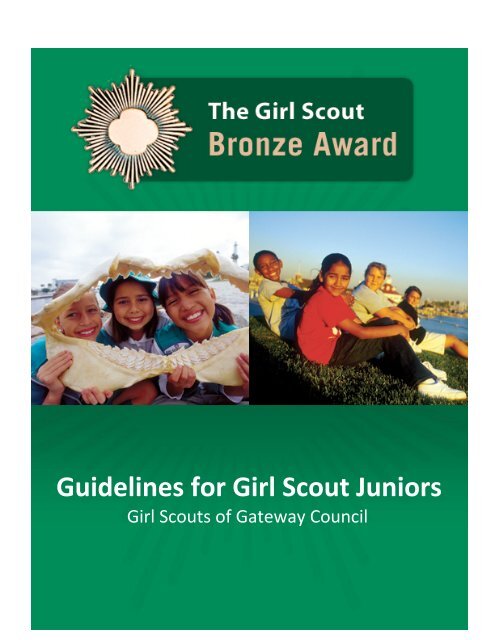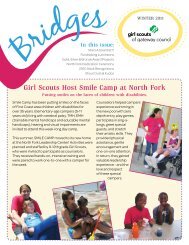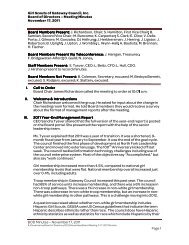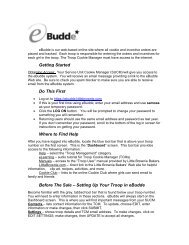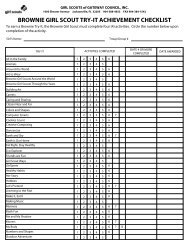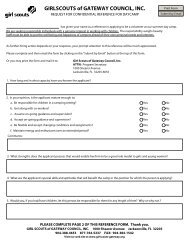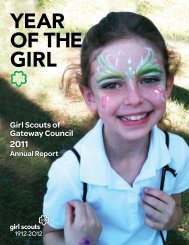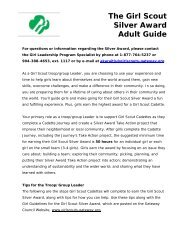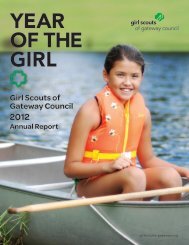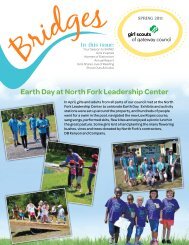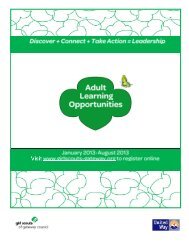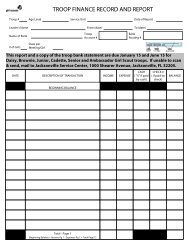Bronze Award Guidelines - Girls - Girl Scouts of Gateway Council
Bronze Award Guidelines - Girls - Girl Scouts of Gateway Council
Bronze Award Guidelines - Girls - Girl Scouts of Gateway Council
- No tags were found...
You also want an ePaper? Increase the reach of your titles
YUMPU automatically turns print PDFs into web optimized ePapers that Google loves.
<strong>Guidelines</strong>for<strong>Girl</strong>ScoutJuniors
<strong>Girl</strong> <strong>Guidelines</strong>The <strong>Girl</strong> Scout <strong>Bronze</strong> <strong>Award</strong>Welcome to the <strong>Girl</strong> Scout <strong>Bronze</strong> <strong>Award</strong>, a leadership adventure for you and morethan half a million other <strong>Girl</strong> Scout Juniors across the country and around the world.Imagine what you can accomplish when you team up with others and use your specialskills and interests to take action and make a difference in the world!As you can tell, this <strong>Girl</strong> Scout <strong>Bronze</strong> <strong>Award</strong> adventure is big—in fact, this award isthe highest honor a <strong>Girl</strong> Scout Junior can achieve. As you and your team plan andcomplete your project, you’ll develop more confidence, meet new people, and have thekind <strong>of</strong> fun that happens when you work with other <strong>Girl</strong> <strong>Scouts</strong> to make a difference.Here are the steps you’ll take to earn your <strong>Girl</strong> Scout <strong>Bronze</strong> <strong>Award</strong>:1. Go on a <strong>Girl</strong> Scout Junior journey.2. Build your <strong>Girl</strong> Scout Junior team.3. Explore your community.4. Choose your <strong>Girl</strong> Scout <strong>Bronze</strong> <strong>Award</strong> project.5. Make a plan.6. Put your plan in motion.7. Spread the word.When you go for the <strong>Bronze</strong> <strong>Award</strong>, you represent what <strong>Girl</strong> <strong>Scouts</strong> can achieve in theircommunities. And, <strong>of</strong> course, you want to do that in a way that’s fun for you—and foreveryone else involved, too! Earning the <strong>Girl</strong> Scout <strong>Bronze</strong> <strong>Award</strong> involves the time tocomplete a journey, and then a suggested minimum <strong>of</strong> 20 hours building your team,exploring your community, choosing your project, planning it, putting your plan inmotion, and spreading the word about your project. The suggested hours help youthink about your commitment to doing your very best with each step. That's differentfor every <strong>Girl</strong> Scout, so these hours aren't a rule, just a friendly reminder. You’re a <strong>Girl</strong>Scout, which means you will earn your award with courage, confidence, and characterand make a difference in the world around you!Step 1: Go on a <strong>Girl</strong> Scout Junior JourneyThe first requirement for earning the <strong>Girl</strong> Scout <strong>Bronze</strong> <strong>Award</strong> is completing a <strong>Girl</strong>Scout journey. If you haven’t done one yet, now’s the time! You can choose either It’s1
<strong>Girl</strong> <strong>Guidelines</strong>The <strong>Girl</strong> Scout <strong>Bronze</strong> <strong>Award</strong>Your World—Change It! or It’s Your Planet—Love It! Most girls say they spend three orfour months on a journey, but that’s not a rule: Take all the time you need.When you’ve finished your journey, you’ll have earned three special leadership awards.Set aside some time to think about all you learned and accomplished. Here are somequestions you might want to think about:• How did you use the values <strong>of</strong> the <strong>Girl</strong> Scout Law during your <strong>Girl</strong> Scout Juniorjourney?• What did you discover about yourself?• Who did you connect with?• How did you take action, and what did you learn?Then take your next step: Creating your very own <strong>Girl</strong> Scout <strong>Bronze</strong> <strong>Award</strong> adventure.Step 2: Build Your <strong>Girl</strong> Scout Junior TeamWhat’s a <strong>Girl</strong> Scout Junior team? That’s you and other <strong>Girl</strong> Scout Juniors who are onthis adventure together, plus your troop/group volunteer. If there are no other <strong>Girl</strong>Scout Juniors in your neighborhood, seek out some friends your age—they can evenjoin <strong>Girl</strong> <strong>Scouts</strong> and earn the award with you! More girls equal more friends, moreideas, and more ways to make a difference.After you’ve built your team, hold a meeting and spend some time getting to knoweach other. After all, making new friends is one <strong>of</strong> the fun parts <strong>of</strong> being a <strong>Girl</strong> Scout!You could start by playing a game, perhaps one that you played on your <strong>Girl</strong> ScoutJunior journey, at summer camp, or at school. Of course, if you’re working with othergirls in your troop, you already know each other quite well. Even so, you probablydon’t know everything about each other. You might be surprised at what you learnabout girls you’ve known since kindergarten!It’s also a good idea to think about what you each enjoy doing the most. Soon, yourteam will explore and choose an idea for a Take Action project. Keep handy yourteam’s list <strong>of</strong> what each member loves to do; it will help you in a few ways:• You’ll know the special talents each <strong>of</strong> you can bring to the project you choose.2
<strong>Girl</strong> <strong>Guidelines</strong>The <strong>Girl</strong> Scout <strong>Bronze</strong> <strong>Award</strong>• You’ll learn more about each team member so that you can be a great TakeAction team.• You may even touch on something that becomes the beginning <strong>of</strong> an idea for aTake Action project!Here are some questions to help you pinpoint your interests:• Do you read everything you can get your hands on—even the back <strong>of</strong> the cerealbox?• Do you love playing with your pets?• Do you spend hours painting, singing, or dancing?Are you always in motion—riding your bike, surfing, or playing soccer?Really spend some time thinking about all the things you love to do, from conductingscience experiments to taking care <strong>of</strong> younger kids to whipping up fruit smoothies foryour friends!At the end <strong>of</strong> your first meeting, talk about what everyone thinks the group should doto be a great team, like “listen to others without interrupting” or “help out at eachmeeting.” Write the suggestions on a large piece <strong>of</strong> paper and post it on the wallwhenever you have team meetings.Step 3: Explore Your CommunityThere are many ways to make a difference, so what’s the best project idea for yourteam? One that you come up with yourselves, <strong>of</strong> course! How can you do that? Thefirst step is to take a close look at what’s going on right around you. Maybe you haveideas from when you did your <strong>Girl</strong> Scout Junior journey—was there a project you didn’thave time for that you could work on now?Start by exploring your community: your block, your neighborhood, or your school. Asyou walk or bike around town, keep your eyes open for ways you can make a positivechange. As you take a bus to school or ride in the car with your parents, look forproblems that should be fixed. (You might even spot something that could makeeveryone’s daily ride on the school bus a little bit better!) As you spend the day inschool, take note <strong>of</strong> how things could be improved.3
<strong>Girl</strong> <strong>Guidelines</strong>The <strong>Girl</strong> Scout <strong>Bronze</strong> <strong>Award</strong>Here are a few tips:• In addition to observing on your own, you can make this a team activity. Gettogether as a group to walk around your school or your block, talking aboutwhat you see.• Keep a notebook handy to jot down what you see, plus any ideas about possibleprojects.• Keep an open mind as you look around! Sometimes, ideas come from seeing aproblem that needs to be fixed, such as people wasting paper in your school.Sometimes they come from seeing a chance for improvement, such as paintinga wall mural that celebrates your neighborhood’s history.• Feeling stuck? Think about something that would make your life better; chancesare, other people have that same idea! For example, maybe you’d like toexercise more because you know it will make you healthier, but you don’t knowhow to get started. Other people might feel the same way. How about creating a“Let’s Move It!” club that meets once a week after school? You can jump rope,play hopscotch, run races—anything that keeps you active!The following Observation List is a great way to keep track <strong>of</strong> your observations. Writeyour observations in the left-hand column, and then write your possible solutions inthe right-hand column. A few examples are listed to get you started. After you havefilled in your chart, circle the three ideas that matter most to you. But don’t worry ifyou don’t have many “Maybe We Could” ideas yet. The important thing is to identifywhat you care about and want to take action on.4
<strong>Girl</strong> <strong>Guidelines</strong>The <strong>Girl</strong> Scout <strong>Bronze</strong> <strong>Award</strong>Observation ListObservationWhat do you see and hear around you? Here areideas for what to look out for, what you see andhear around you.Our <strong>Girl</strong> Scout meeting space isn’t very“green,” and we’d also like to make thespace more fun for younger <strong>Girl</strong> <strong>Scouts</strong>.A recent flood damaged more than 100homes in town.Maybe We Could . . .Possible project ideas to make a difference.Add fun decorations that are also“green,” and figure out how muchenergy we use during our meetings.Find out how people prepare for floods;think <strong>of</strong> ways to share what we learned.Add your own . . . what else do youobserve in the course <strong>of</strong> a day in yourlife?Here are a couple <strong>of</strong> examples to show how an observation led to a Take Action project(steps 4–6 will give you more tips about how to do the same thing yourself):Example #1Lucia and her Junior team were going after their <strong>Girl</strong> Scout <strong>Bronze</strong> <strong>Award</strong>, so they allagreed to be extra observant <strong>of</strong> everything going on around them. Here’s what Luciaobserved and how it turned into their Take Action project:5
<strong>Girl</strong> <strong>Guidelines</strong>The <strong>Girl</strong> Scout <strong>Bronze</strong> <strong>Award</strong>1. First, Lucia noticed that cars whizzed down the street near their school. Thishappened a few days in a row—it seemed to be a real problem.2. Then, she heard on the news that in the last year there had actually beenseveral accidents in that same area.3. The Junior team asked their troop/group volunteer to help them find out howpeople in their community decided where stop signs were needed.4. After a visit to both the police station and a local government <strong>of</strong>fice, here’s whatthe Juniors did: They wrote a petition, asking for a new stop sign on the roadnear their school, got local residents to sign it, and then presented it to theirlocal government <strong>of</strong>ficials. Result: A new stop sign, slower traffic, feweraccidents, and safer kids! Plus, a stop sign is a permanent solution!Example #2Tanya and her Junior team also decided to be extra observant for a week or two. Whenthey got together to share what they observed, Tanya asked her friends, “Have youever noticed how hard it is for older people or people with disabilities to get around thegrocery store?” The team agreed that this was a problem that no one seemed to beaddressing. It seemed like a good challenge for their team! Here’s what they did:1. First, they decided to visit the store together and just watch as people shopped.This convinced them that some people could use a little extra help.2. Then they met as a team and brainstormed how they could help and how theycould explain their project idea to the store manager.3. Next, they met with the store manager. Here’s what happened next: The girlsgot permission to team up during the peak holiday season and <strong>of</strong>fer theirassistance to shoppers. Sometimes they would take a person’s grocery list andgo up and down the aisles to get products. Other times, they would walk aroundthe store with people and help them fill their baskets. In both cases, they helpedpeople get through the checkout line and out to their cars. To keep this projectgoing, they wrote a tip sheet about how other youth and volunteer groups cando the same thing.6
<strong>Girl</strong> <strong>Guidelines</strong>The <strong>Girl</strong> Scout <strong>Bronze</strong> <strong>Award</strong>Step 4: Choose Your <strong>Girl</strong> Scout <strong>Bronze</strong> <strong>Award</strong> ProjectNow that you’ve observed what’s going on in your community, here are some steps totake in order to choose your <strong>Girl</strong> Scout <strong>Bronze</strong> <strong>Award</strong> project:1. Meet with your team to share what you’ve seen. You might find that many <strong>of</strong>you noted the same problems or ideas. Your troop/group volunteer can help youmake a list <strong>of</strong> the top observations from all the girls on the team.2. Brainstorm ideas about where you can make a difference, based on what you’veseen. Once you have a list that everyone likes, work together to choose the topthree topics that interest everyone the most.3. Now that you’ve come up with your top ideas, you need to get more informationso you can understand how you can best help make a difference. Here are a fewtips to get you started on your fact-finding mission:• To really understand a problem, you need to get information from manyplaces—talking to different people, reading newspaper and magazinearticles, and doing research at the library and on the Internet.(Remember to first take the <strong>Girl</strong> Scout Internet Safety Pledge atwww.girlscouts.org/internet_safety_pledge.asp.) This may seem like a lot<strong>of</strong> work, but don’t worry, you can share the jobs—after all, that’s whatteams are for! One person can go online to read newspaper articles,someone else can volunteer to check out books from the library, and soon.• Brainstorm with your team and your troop/group volunteer about whereto get more information. You can also visit the library and talk to thelibrarian. That’s a great way to get suggestions <strong>of</strong> who to talk to—and getideas for a great project.• It can be hard to talk to adults, especially if you don’t already know them!Talk about your ideas with your teachers and neighbors first—you’ll startto feel more confident about asking questions <strong>of</strong> other adults. Andremember that you’ll be with other members <strong>of</strong> your team as you talk toadults, and that always helps!• Take notes about what you learn as you do your research. A blank ProjectIdea Chart is included at the end <strong>of</strong> this guide for you to write down who7
<strong>Girl</strong> <strong>Guidelines</strong>The <strong>Girl</strong> Scout <strong>Bronze</strong> <strong>Award</strong>you talked to, what you learned, and your ideas for the kind <strong>of</strong> projectyou can create. Here are a few project ideas—take a look, and then addyour own in the blank Project Idea Chart at the end <strong>of</strong> this guide!Project Idea ChartObservationsOur <strong>Girl</strong> Scoutmeeting space isn’tvery “green,” andwe’d also like tomake the spacemore fun foryounger <strong>Girl</strong><strong>Scouts</strong>.A recent flooddamaged morethan 100 homes intown.Who We TalkedToOther <strong>Girl</strong> <strong>Scouts</strong>and their families,including younger<strong>Girl</strong> <strong>Scouts</strong>The owner <strong>of</strong> alocal hardwarestoreAn emergencymedical technician(EMT)A firefighterA Red Cross<strong>of</strong>ficialFamilies who haddamaged homesWhat WeLearnedWe can turndown the airconditioner andadd plants tomake our space“greener.”Younger <strong>Girl</strong><strong>Scouts</strong> would liketo help decorateour space.Everyone’sinterested inseeing what girlsin othercountries looklike.Many familiesaren’t preparedfor disasterssuch as floods,hurricanes, andtornados.Everyone shouldbe aware <strong>of</strong> thesteps to take inorder to staysafe.Maybe We CouldHave a familyworkday wheneveryone can cometogether to clean andpaint.Post photos <strong>of</strong> <strong>Girl</strong>Guides and <strong>Girl</strong><strong>Scouts</strong> from aroundthe world.Turn down the airconditioner or usefans.Work with younger<strong>Girl</strong> <strong>Scouts</strong> to createa colorful papermural.Do presentations ondisaster preparednessat school and places<strong>of</strong> worship.Include a simple firstaid-skillssession anda discussion aboutthe impact <strong>of</strong> naturaldisasters around theworld.Hand out flyers thatlist what familiesshould include inhome emergencykits.8
<strong>Girl</strong> <strong>Guidelines</strong>The <strong>Girl</strong> Scout <strong>Bronze</strong> <strong>Award</strong>Use the Project Idea Chart at the back <strong>of</strong> this guide to explore your top ideas. Once thechart is complete, it’s time to choose your project.Look at how much you’ve already learned! Now your <strong>Girl</strong> Scout Junior team can startnarrowing your three ideas to one. Before you decide, answer these all-importantquestions about each <strong>of</strong> your ideas:• Why does this idea matter?• Who will this idea help?• What can we do to make a difference? Is that realistic?Write down your final choice here: ___________________________As a <strong>Girl</strong> Scout, you’re a member <strong>of</strong> the worldwide community. Once your team haschosen a project idea, take some time to talk about how people in other parts <strong>of</strong> theworld might address the same problem. This doesn’t mean that you have to solve aworldwide problem! However, when you’ve finished your project, you may want tothink <strong>of</strong> ways to tell your story to people in other places so they can learn about whatyou did.Step 5: Make a PlanNow that you’ve chosen an idea, it’s time to make a plan. It’s always good to thinkbefore you take action. That way, you can aim for success! The following questionshelp you think through your plan before you get started. Also, remember to go back toyour journey(s) for other great tips on project planning!As a team, answer these questions:• What is our goal for the project? (If you’re tackling a big issue, narrow yourfocus to just one part <strong>of</strong> the problem. That will make your goal easier toachieve.)• What steps do we need to take to reach our goal?• What special talents can each girl use to help make the project a success?• What did we learn when we did our <strong>Girl</strong> Scout Junior journey that will help makethis project run smoothly?9
<strong>Girl</strong> <strong>Guidelines</strong>The <strong>Girl</strong> Scout <strong>Bronze</strong> <strong>Award</strong>• Who can we ask for help?• How can we get other people involved?• What supplies will we need?• Do we need to earn money for our project or can we get donations from people?If we do need money, how can we earn it—or how can we change the project sothat it doesn’t cost anything? Can we use the money from our cookie sales t<strong>of</strong>und our project?• How much time do we need to finish our project? Is that realistic?Once you have some idea <strong>of</strong> your plan, ask yourselves if there’s anything you can addor adjust that will help make a difference even after your project ends? For example, ifyour project helps your school, maybe a teacher, principal, or PTA member wouldagree to do it again next year.Here’s an example <strong>of</strong> how a team made sure their project lasted: Alina and her teamwanted to make new students feel more at home at her school, so they organized a“Get to Know You” day. It was a success, but it won’t help students who came to theschool after “Get to Know You” day. To make their plan last longer, Alina and her teamdecided to start a student-run “What a Pal!” buddy program for new students. Theyran the program until they graduated, and then they asked the principal to continuethe program after they left the school. That way, new students will always have afriend, no matter when they moved to the school.Now that you’ve answered these questions, take a step back. Does it sound like youhave a good plan? How do you know? Don’t worry, you’ll have plenty <strong>of</strong> help. Yourtroop/group volunteer is always there to help you and answer questions.Tip: You and your team may want to sit down with your troop/group volunteer and goover your plan one last time before you begin, just to make sure your plan is realistic.You may need to adjust it slightly before you start. That will make reaching your goal alittle smoother.Before you move on to the next step, fill in the following sentences. This will help youtalk about your project to other people as you start putting your plan into motion.We will make a difference by__________________________________________________________________________________________________________________.10
<strong>Girl</strong> <strong>Guidelines</strong>The <strong>Girl</strong> Scout <strong>Bronze</strong> <strong>Award</strong>We hope our project will help _________________________________________________________________________________________________________________.When we’re done, we’ll know we made a difference because ________________________________________________________________________________________.Step 6: Put Your Plan in MotionNow that you have an overall plan, it’s time to create a list <strong>of</strong> tasks and deadlines andfigure out who will be doing what. Remember, you’re a team, so one or more girls canvolunteer for each task. Decide when each task needs to be finished. Then write all theinformation in a Planning Chart like the one that follows. (There is a blank PlanningChart at the end <strong>of</strong> this guide for you to use.)Planning ChartWhat Is theTask?How Will theTask BeDone?When ShouldThis Task BeFinished?Which TeamMember(s) WillComplete the Task?Gather informationDo research onOctober 17Alina and Leahabout preparingthe Internet orfor a flood,at the library.tornado, orhurricane.InterviewemergencyMariah, Carole, Annaworkers.Create sampleUse research toNovember 14Tasha, Orna,home emergencymake a list <strong>of</strong>Michelle, Patricekits.what should bein the kit; getdonations fromfamilies or thelocal hardwarestore.11
<strong>Girl</strong> <strong>Guidelines</strong>The <strong>Girl</strong> Scout <strong>Bronze</strong> <strong>Award</strong>When your list is complete, it’s time to get started. Talk as a team about yourprogress. You might have to be flexible and switch assignments around or add moretasks—that’s good teamwork.Keep a record <strong>of</strong> what you’re doing! Take photos, shoot video, or draw pictures, alongthe way. These will help you share your story when you’re done.Step 7: Spread the WordCongratulations! You and the <strong>Girl</strong> Scout Junior team have created and carried out aproject that makes a difference in the world around you! Great job! Now it’s time tothink about what you did, why it mattered, and what you learned.First, thank everyone who helped you. They’ll be glad to hear what you were able toaccomplish with their help!Second, put your story together so that you can share it. You’ll be able to show whatyou learned and your story may help others! Here are a few tips for capturing andsharing your story:• Organize your story by answering these questions:ooooooooHow did you decide what was needed in your community?What did you discover about yourself from this experience?How did your team work together?What problems came up? How did you solve them?What leadership skills did you use?What did you do to inspire others to act?How do you feel you and your team have made the world a better place?How did you live out the <strong>Girl</strong> Scout Promise and Law?• Be creative in the way you tell your story! Make a photo collage, put together ascrapbook, create a short film, or write a play about what you did and what youlearned.12
<strong>Girl</strong> <strong>Guidelines</strong>The <strong>Girl</strong> Scout <strong>Bronze</strong> <strong>Award</strong>Planning ChartWhat Is theTask?How Will theTask Be Done?When ShouldThis Task BeFinished?Which TeamMember(s) WillComplete theTask?14


